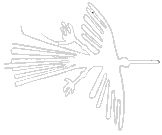 | SOUTH
AMERICAN PICTURES | ||
| Cuba |
| From
a book by MARION MORRISON |
 |
Cuba's
place in history is unique. Since the revolution in 1959 that brought the present
government to power the island has seen many changes. Today, perhaps the most
popularly talked about matters concern tourism, an industry that draws about a
million visitors every year. But behind the sun soaked Caribbean beaches and Cuba's
very individual pusuit of freedom there is an unforgettably relaxed day-to-day
life with children, schools, universities and sport. | |||
Back in 1997 Marion was asked to write an educational book comparing the lives of children in Havana and the lives of those living in República de Chile a small farming settlement in the western end of the island. Marion travelled with Tony and it was her first visit to Cuba. "When help from the USSR [Soviet Russia] was withdrawn in 1989, many people thought that the Revolutionary Government would collapse. But the Cuban people kept the country going "
Her book Cuba for the Country Insights series took her to many parts of the main island, to the cities and rural areas.
 | 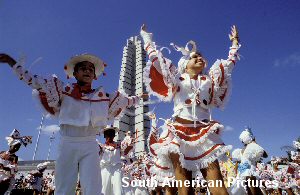 | |
| Havana
, the capital looks over the Gulf of Mexico | Dancers in a celebration of the 1959 Revolution at the base of the Martí Monument, a tower built to honour José Martí, Cuba's greatest patriot |
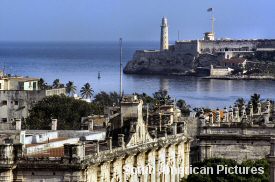 |
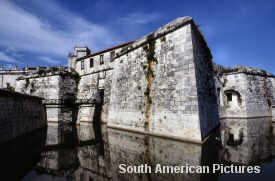 |
| The
Castillo de Los Tres Reyes Santos del Morro | Castillo
de la Real Fuerza with walls six metres thick. |
After those early Spanish days came the introduction of black slaves from Africa and apart from raids by pirates or foreign fleets colonial life was luxurious . Then followed the movements towards independence from Spain, the close ties with the USA in the early 20th century, the now famous yet almost forgotten Revolution of 1959, and ultimately in recent years the Cuban struggle to survive in severe economic isolation.
Central
Havana is not so modern as some of the outskirts. The main features are many well
cared-for tourist attractions including museums. Some parts of the old city built
in the 19th century are being lovingly restored but in 1997 large areas were seriously
negelected. 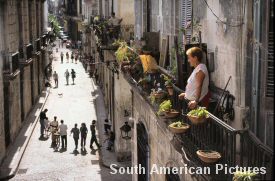 What
were once magnificent buildings from the 19th century and early 20th were used
for housing with many families living in one large space. Sometimes there was
apparently too much space leaving rooms light and airy while sometimes a room
would be split into two levels. Cooking facilities were usually simple and food
was rationed. Bottled gas was the most usual form of heating a stove.
What
were once magnificent buildings from the 19th century and early 20th were used
for housing with many families living in one large space. Sometimes there was
apparently too much space leaving rooms light and airy while sometimes a room
would be split into two levels. Cooking facilities were usually simple and food
was rationed. Bottled gas was the most usual form of heating a stove.
Like
many visitors we were surprised at the working condition of some of the classic
cars - mostly North American from the 1950's. Few other countries
in Latin America have so many fine examples of classic cars and perhaps only Uruguay
can boast as many. Often those in Uruguay are from European manufacturers. 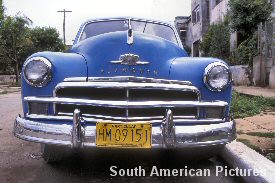 Some
of the Cuban cars are in a PORTFOLIO by our associate Brian Usher.
One proud owner explained "We find plenty of spare
parts from the Russian built Ladas. They were a contemporary design."
Some
of the Cuban cars are in a PORTFOLIO by our associate Brian Usher.
One proud owner explained "We find plenty of spare
parts from the Russian built Ladas. They were a contemporary design."
República de Chile It is perhaps a curious name for a village and it was given in honour of the South American country Chile, the Chilean Republic at the time of the Marxist President, Salvador Allende, democratically elected President of Chile in September 1970. It is about 10kms from Viñales in the tobacco growing region noted for its scenery and tourism. The relatively modern village comprising concrete apartment blocks, a school, health centre and a couple of stores is set amongst a more rural scene of traditional bohíos - literally meaning 'shacks' - though far from that as they are thatched country style homes. We arrived at the tail-end of the rainy season in late October, not long after Hurricane Lili had swept across the centre of the island. The farmers in Viñales who grow tobacco for the world famous cigars were not so seriously affected as those in the island's heartland.
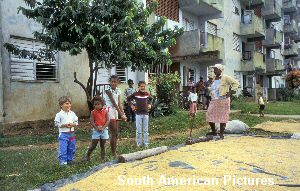 |
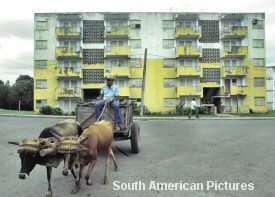 | |
| Crops drying on a tarpaulin laid on the ground outside an apartment housing block. | Transport is often home -made. It is simple and environmentally friendly. |
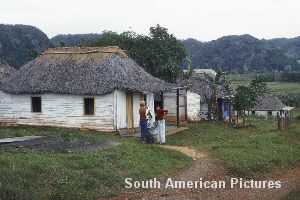 | 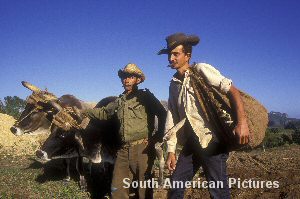 | |
| A bohÍo - a traditional thatched cottage in a rural village | Tobacco
farmers in the Viñales valley |
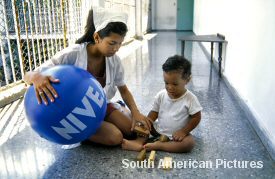 |
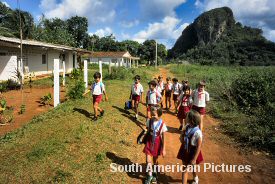 |
| A
young nurse plays with a child in one of the many super - crêches |
On the way to a rural school |
We also travelled extensively in other parts of the island, visitng many schools, and hospitals as well as the well supported circulos infantiles, or super-crêches. There the young children are attended by nurses and special teachers while their parents are working . Education was everywhere with schools, universities and colleges with different courses. At every stop we were asked about education in 'our country' and inevitably comparisons were drawn. The sheer dedication of the Cuban students to learn was impressive. Doctors and technical specialists were graduating by the score and knowledge seemed to be bursting from anyone met on the street. At every stop there was tremendous warmth in the welcome we received and we were soon invited to eat or have a can of beer while chatting about almost anything. In one town we met an historian who knew the history of Cuba almost end to end, year by year.
Family life A close family life is the trademark of Latin America and nowhere is it more obvious than in Cuba. Possibly the pressure on housing keeps the people together and the family unit was clearly a support in the hard times following the withdrawal of the Soviet help.
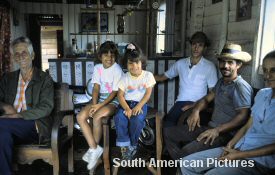 |
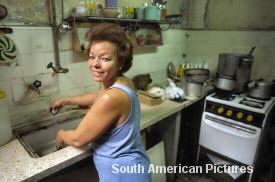 |
| A rural family with three generations living under the same roof | With more space in one of the older houses in Havana |
The cover picture for Marion's book by our associate, Cuban photographer Rolando Pujol, was taken in the Plaza de la Revolución in Havana with a group of primary school children. The image of the revolutionary hero Che Guevara looks out from the side of a government building.
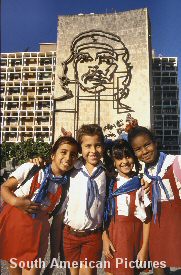 |
For
the photography we relied heavily on the work of Rolando Pujol and more of his
images will be presented in the Image Archive guide. Altogether we spent about
two months working on the background for the book. Once back in Havana we took
time off to visit the famous spots of which the Tropicana is the most glamourous
'show' in the capital. The performances are well staged to satisfy the new era
of tourism. 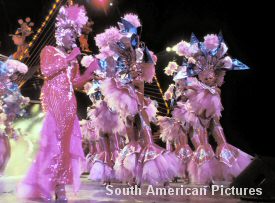 The
high kicking girl dancers, the rum filled mojitos with their rich aroma
of fresh lime and the dollar bills seemed far removed from the simple life in
the country
The
high kicking girl dancers, the rum filled mojitos with their rich aroma
of fresh lime and the dollar bills seemed far removed from the simple life in
the country
Here and there traces remain of the days when this city was the playground of the Caribbean. Ernest Hemingway's favourite bars La Bodeguita del Medio and La Floridita are still open but others such as the much loved 'Sloppy Joe's' have long since closed. Sloppys' was derelict and only a mosaic on the pavement gave a clue to the past colourful history that has given a name to bars in the USA and an list of cocktails inside.
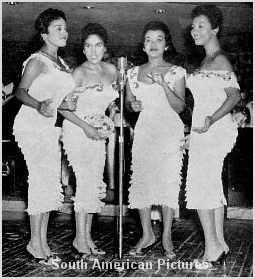 | 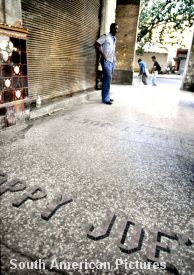 |
| The nightlife in pre-1959 Revolution Havana was the well known to American visitors and others calling at the port. | |
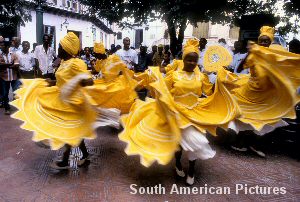 |
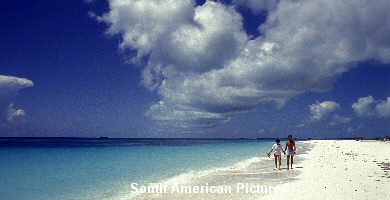 |
| | |||
All
the pictures are copyright © | |||
For
information about any of the photos in the archive or to request a larger selection
or for any use please send an e-mail to | |||
| | |||
|